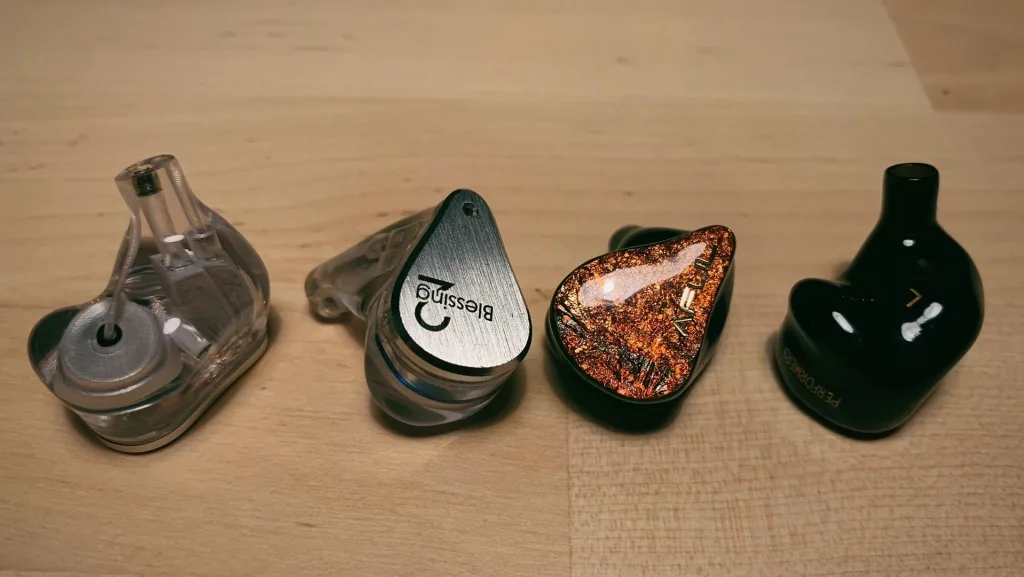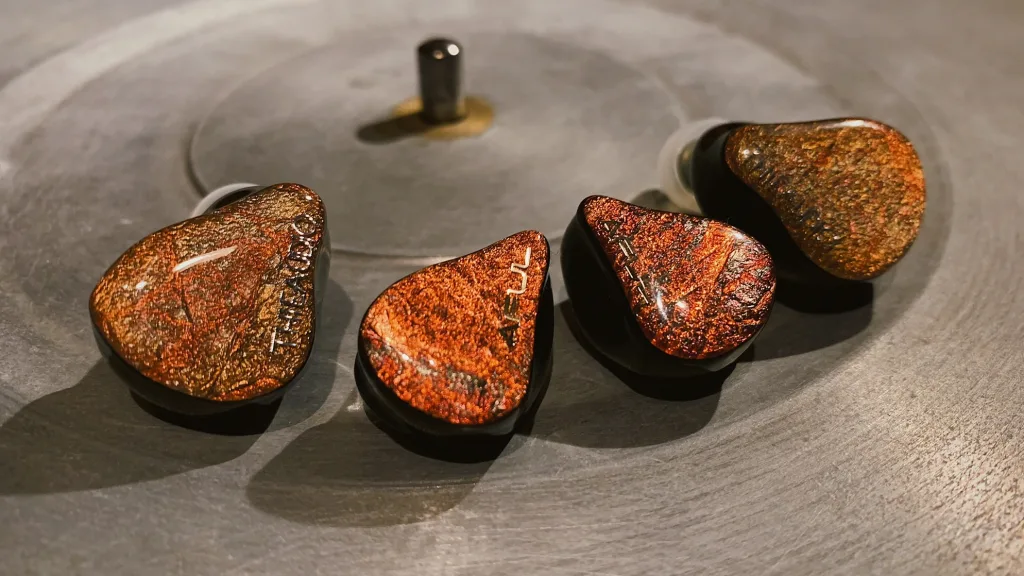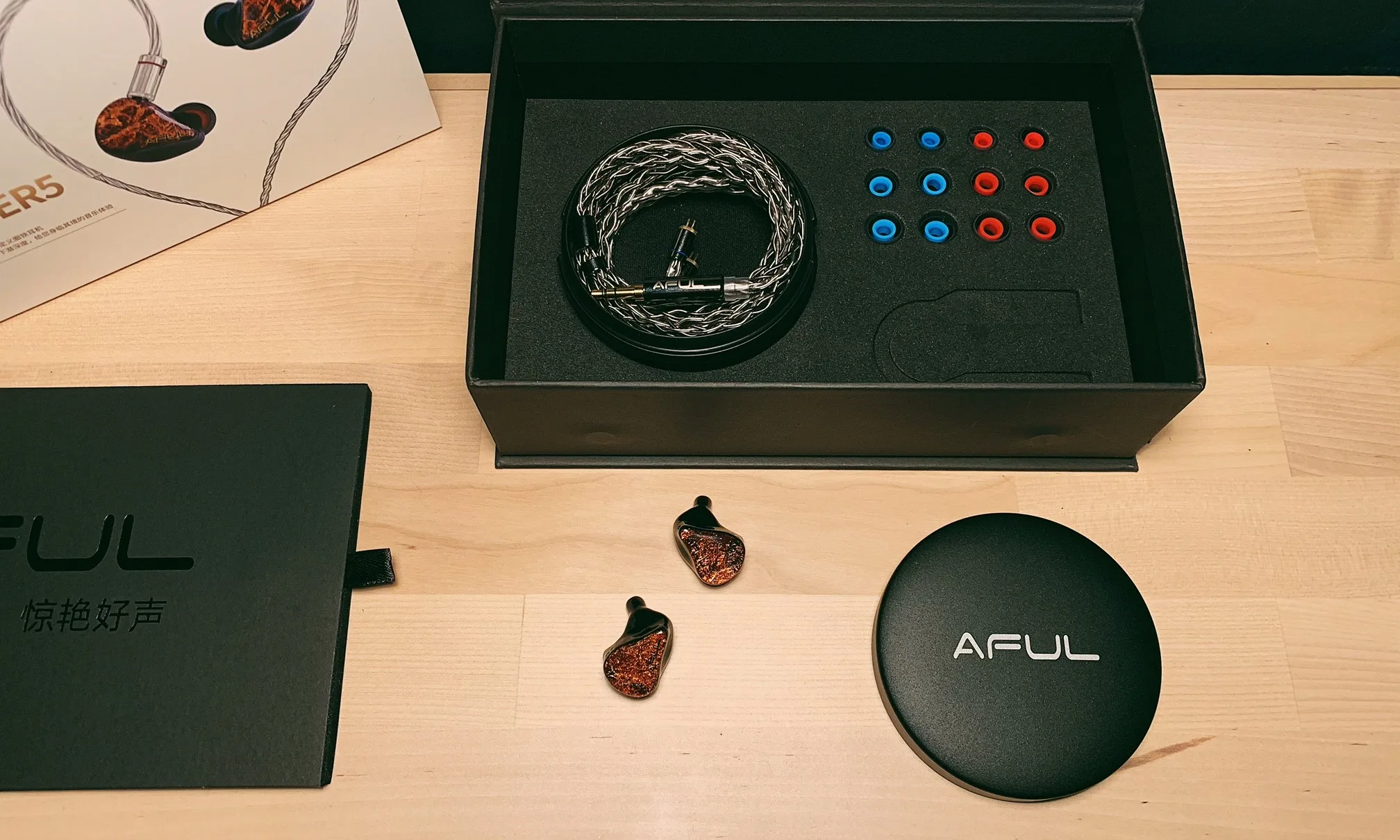Intro
As we have heard, there’s a new rather good-looking kid on the block making noise and all but mind you, this is not a common kid. First of all, I want to give a warm welcome to AFUL in this never-ending quest for sonic ecstasy. I believe it’s always a good thing to see new competitors in the market every now and then, especially the ones that bring “new tech” or new sound to the table, because most of the time, news is always better.
AFUL claimed that they have the latest technologies that “break through the sound quality barriers of the traditional hybrid design” with their firstborn Performer 5. There are mouthfuls of designs and patents that played a part in the production of Performer 5 after 3 years of research and innovation. Usually, I don’t really bother about the long story behind a product, but I find it’s rather nice for companies to be transparent and bold. But the same question remains, how good is Performer 5?
Packaging & Accessories
As a new company, it’s evident that AFUL studied the market to be as competitive with the offerings of their debut product. Performer 5 comes in well-constructed minimal packaging with the expected standard of accessories consisting of 6 pairs of silicone ear tips, a circular hard carrying case, and a good quality 8-core single-ended cable except for foam tips.
The build quality is very good with a relatively small shell size, and they are quite light in weight. It’s all 3D printed including some special air pressure & damping designs, and I can confirm that I have no issues regarding the fit and comfort every time I put them in my ears. They are really comfortable but as we all know, one mileage may vary.
Specifications
Configuration: 1DD + 4BA
Frequency response: 5Hz – 35kHz
Sensitivity: 110dB @ 1kHz
Impedance: 35 Ω
Retail Price & Where to Get
We would like to thank HiFiGo for sending this review unit to us. AFUL Performer 5 is currently priced at $219.90
HiFiGo : https://hifigo.com/products/aful-performer-5
Amazon : https://www.amazon.com/dp/B0BN45CJX4/aful+performer+5/?tag=headfi-20
Aliexpress : https://www.aliexpress.us/item/1005004987586619.html?gatewayAdapt=4itemAdapt
Source pairing
Tidal via Windows -> Topping EX5
Foobar2000 via Windows -> Topping EX5
Apple Music via iPhone 6s -> with/without Cayin RU6
Tidal / Apple Music via LG G7 -> with/without Cayin RU6 / Hidizs S9 Pro / Ovidius B1
Apple Music via MacBook Pro
FiiO X1
*Please note that I used everything stock for this review for 2± weeks of listening time. My preferred signature is neutral with or without a bass boost, but truly I’m a signature agnostic when it comes to gear review.
Test Tracks
Será Una Noche – Taquito Militar (Tango)
https://tidal.com/browse/track/11968729
Patricia Petibon – Mozart: Der Zauberflöte – Der Hölle Rache kocht in meinem Herzen (Classical [Aria])
https://tidal.com/browse/track/39114574
Sinne Eeg – We’ve Just Begun (Jazz)
https://tidal.com/browse/track/128215119
Mariya Takeuchi – Plastic Love (City Pop)
https://tidal.com/browse/track/202455348
Florence + the Machine – King (Chamber Pop / Pop Rock)
https://tidal.com/browse/track/228279664
Don Caballero – Don Caballero 3 (Math Rock)
https://tidal.com/browse/track/61686258
Scott Walker – Corps De Blah (Experimental / Post-Industrial)
https://tidal.com/browse/track/18172874
Interpol – Barricade (Post-Punk Revival)
https://tidal.com/browse/track/23303855
Mastodon – Divinations (Progressive Metal / Sludge Metal)
https://tidal.com/browse/track/71830324
Björk – Where Is the Line? (A cappella / Art Pop)
https://tidal.com/browse/track/90087194
Lingua Ignota – The Sacred Linament of Judgment (Neoclassical Darkwave / Avant-Folk)
https://tidal.com/browse/track/184963261
Massive Attack – Unfinished Sympathy (Trip Hop / UK Hip Hop)
https://tidal.com/browse/track/17691649
Drake – One Dance (Pop Rap / Contemporary R&B)
https://tidal.com/browse/track/77690162

Signature & Presentation
On paper, the sound signature of Performer 5 can be described as neutral with a bass boost that emphasizes the sub-bass that glides smoothly to the mid-bass and with a sort of “polite” pinna gain. It could be described as mild V-shaped depending on one’s sensitiveness to the treble but it’s virtually not quite Harman.
On subjective listening, while it boasts a great rumble, it’s surprisingly great at delivering punch and slam too. 2 of the best (preference) bass aspects combo that’s rarely found in IEM. I guess the frequently-talked-about technologies behind it are working, and I can confirm that they work well as a unit. From my observation, this kind of neutral tuning makes the whole frequency spectrum appear more even and closer relative to loudness while having a good note weight and warmth. Instruments also appeared closer to each other in the mix.
Tonality
Bass
A potent bass response has been my not-so-recently adopted criteria in music reproduction gears after being a moderate “neutral head” for the most part of my head-fi years. This “potent” bass must include a good amount of sub-bass rumble while not discarding the required amount of mid-bass kick & punch together with good texturing and agility without disturbing the melody lines. For the asking price, I could say that Performer 5 does all this with flying colors and in an effortless manner especially for energetic drum-forward music, though it may get a bit congested on busy passages sometimes, such can be heard in Don Caballero’s “Don Caballero 3”.
1991’s Massive Attack’s “Unfinished Sympathy” starts off with a sort of sub-bass boosted kick drum programming that rumbles on the left stereo field before the actual kick drum and percussion sampled in the center. While it reproduces excellent rumble, Performer 5 also shows a good separation between the sub-bass and mid-bass instruments with good texturing. However, I think some people might perceive the bass texture as a bit “blurry” or “bloomy” (like most sub-bass focus sets) simply because of the nature of its “intimate” presentation which makes it a bit difficult to see the whole picture altogether. It’s like watching a screen monitor up close rather than watching from 2 meters back if that makes sense. Nevertheless, I still think that the bass could be a tad better in terms of texture or overall quality. In other words, I think Performer 5 has everything that you could ask for “a bass” at this price point.
Midrange
The midrange of Performer 5 is quite neutral without displaying the “thinness” that plagues most neutral IEMs I’ve heard. This is because of the moderate pinna gain as a tuning choice that rarely shows any hint of shouty-ness but rather introduces a bit of “lushness” & smoothness without being dull. Vocals are still forward yet some may appear a bit buried or hidden in the music but also depending on the mixing style. Nothing sounds out of place or too colored, yet full-bodied, rich, and “natural” to my ears.
Treble
The treble response is neutral and linear from the midrange where the overtones of midrange instruments seam evenly with their fundamental frequencies. This is indeed one of the smoothest BA trebles I’ve heard, yet it has ample energy with crisp attack and decay and can be considered “natural” for a balanced armature. There are no weird peaks or wonky dips so there’s no hint of harshness or sibilance to be noted, yet I wish it to have slightly more shimmer, sparkle, and extension here and there even though I wouldn’t consider them lacking in overall playback. On a side note, I find wide-bore ear tips such as Azla Sedna Earfit Light help to give a more palatable treble response where the upper treble has a bit more breath and better coherency between the lower treble and the upper midrange. Overall, I think Performer 5 has a good tonal balance with a few minor things to nitpick rather than fault.
TLDR; AFUL Performer 5 is tonally inoffensive yet energetically & sonically satisfying to a great extent.
Technicalities +
Resolution-wise, I’d consider Performer 5 as “not bad” or rather “decent” in the grand scheme of things. It’s obvious there’s a trade-off for the smoothness it presents where the note definition comes off as slightly blunted even compared to other IEMs with the same driver configuration (or less). Given its somewhat “fuzzy” attack, Performer 5 mostly lacks the delicate nuances or subtleties in well-produced music such as Scott Walker’s “Corps De Blah” or Florence + the Machine’s “King”.
On a positive note, it’s highly dynamic in terms of macro decibel shifts that demonstrate nimble attacks & releases with impactful slams & sustains, though I’m not so impressed with the micro dynamics. For example, the string & horn attacks in Mozart’s “Die Zauberflöte” by Patricia Petibon & Concerto Köln feel slightly relaxed and soft, but I wouldn’t say it’s bad either. It’s just a nitpick that I can’t ignore most of the time.
Soundstage & Imaging
The sound stage is rather average but might appear as wide because of its intimate presentation that we talked about previously. As we all know, the sense of space and depth is partially governed by the type of ear tips used and how much wattage one’s feeding in music playback. In this case, I find there’s a better perception of depth at a moderate loudness level than cranking it loud which makes the stereo projection go a few steps back for a better overall “head-view”. It’s not an issue for me but it could be a deal-breaker for some to have every piece of information presented very near or aligned to one’s head.
Imaging is all nice with more density in the lower details than the upper parts but not as vivid or strong as what I’d call “true holographic”, especially with its close projection that seemed “2-dimensional”. However, one could argue that Performer 5 has near-holographic imaging where it’s not hard to point out and focus on any instrument in the “stereo field” although it lacks clarity in terms of positional cues. Its intimate sound staging is also the reason for its 2-dimensional and “in-your-head” effect in the lingo of overall imaging. Moreover, the background is also not as dark as what I’d prefer which can be found in IEMs like ThieAudio Oracle. Generally, I can say that the imaging is not as sharp or well-formed yet it’s able to produce a quite holographical sense of the stereo image.
Separation & Timbre
Instrument localization is decent as it relates to its average positional cues and sound stage which are all derivatives of the imaging itself. There’s ample “air” to separate instruments reasonably although they are projected very close to each other. One might find overlapping notes at times, but my report is that it hardly happens; depending on how many instruments are played, some overlap and smearing can occur and create a little bit of congestion.
There are hints of minimal BA timbre, and it could become more apparent when pushed, though I find it still very minimal & well-controlled; I don’t think that anyone would crank it that loud. In my opinion, Performer 5 is quite cohesive as a hybrid as it almost sounds like a very technically capable single dynamic driver on many occasions. The BA used for the treble range is tuned for smoothness and moderately extended, yet it’s able to maintain a good amount of “authority” of the common balanced armature transient attack, but I doubt it will satisfy hardcore treble-heads in the long run.
Perhaps thanks to its RLC crossover technology & its large headroom, one could enjoy their “harsher” music at a desirable loudness with pleasantness. Substandard production and lo-fi metal music never sounded so rich and satisfying.
A little reminder that this is all relative to the standard of IEMs that I’d consider TOTL in terms of technicalities, nevertheless, I still think Performer 5 should be sufficient & capable enough in its own right.
Drivability & Synergy
Performer 5 is assuredly very easy to drive even with low voltage output devices like older DAPs and smartphones, but it will appreciate & benefit from a higher output power. Neutral to bright-sounding sources are most recommended to complement the nature of Performer 5’s sound signature. In my case, I find the single-ended Ovidius B1 to be a better pair for Performer 5 than the analog-sounding R-2R resistor ladder dongle Cayin RU6. Performer 5 & Ovidius B1 combo is deadly glorious and extremely fulfilling.

Comparison
For comparison, I could not think of any better IEMs than the (in)famous Blessing 2 for the same driver configuration and as a benchmark set even though it’s about $100 pricier. Realistically, Blessing 2 Dusk is a better challenger for its sub-bass focus tuning, but apparently, I don’t have it in my hand during this review. From the same price point perspective, there are others like See Audio Yume Midnight, 7Hz Timeless, Dunu Falcon Pro, and ThieAudio Elixir to name a few, but they are different in terms of driver config. So, I’m going with Blessing 2.
In terms of tonality, Blessing 2 comes off as more neutral with an actual forward midrange and leaner bass response that emphasizes the mid-bass over the sub-bass. On the other hand, Performer 5 has a more polite upper midrange that sounds fuller with thicker note density. There’s mild to strong shouty-ness and sibilance on Blessing 2 but there’s almost none to be noted on Performer 5. For example, Performer 5 shows a strong resistance towards sibilance in the first verse of Interpol’s “Barricade” or Bjork’s “Where Is the Line?” that’s very noticeable and unpleasant sounding with Blessing 2. Other than that, Performer 5 is also better extended on both ends of the frequency spectrum, especially the sub-bass.
For the intangibles, it’s safe for me to say that Blessing 2 is more analytical and more detailed with better overall resolution. It’s cleaner, tighter & more disciplined in the upper half of the frequency range, with sharper imaging toward realism. However, I suspect that Performer 5 has a better-quality dynamic driver that does everything better in the lower half of the frequency spectrum other than the advantages of the new acoustic structure design. With its intimate presentation, Performer 5 also boasts a larger spatial imaging with a wider stereo effect.
One of the negative points about Blessing 2 is that it lacks headroom. I find Blessing 2 distorts earlier than Performer 5, which gives a sort of “compressed” quality or commonly known as “BA grain” when pushed to a higher loudness level. Based on the specifications, Blessing 2 is supposed to be the easier set to drive, yet Performer 5 requires a lesser amount of power and can be cranked louder with less to no distortion. There’s plenty of headroom even paired with low-powered devices.
Objectively, one could say that Blessing 2 is the better set overall, but this is where preferences come to draw the line. From my perspective, Blessing 2 is a real reference-style studio monitor where one could analyze while enjoying their music at a moderate loudness whereas one could have more enjoyment with a more full-sounding, musical & livelier music reproduction of Performer 5 at any desirable loudness level.

For whom?
It’s obvious to me that Performer 5 is made for people who prefer musicality and “naturalness” over technical chops in their music playback without losing too much detail, and for those who listen to loud music and those who listen to music loud.
Evaluation & Conclusion
As much as I wanted to have the best detail possible in my music playback, I also wanted the kind of musicality that I always savored back then in my teenage years, though I know it’s kind of hard to find a good balance between both worlds nowadays, especially from a certain price tag. AFUL Performer 5 is a rare case where I find myself basking in the music more than analyzing the details which makes me question the purpose of this hobby over and over again after every listening session.
Other than the questionable name choice of the company (honestly, I’m tired of the same joke), I think that AFUL has made an excellent debut that’s greatly pleasing in many aspects of pure musical satisfaction which I believe deserves its place high in the community and every enthusiast. With that being said, I’m going to name Performer 5 as one of the best 2022 releases if not the best in the $200 – $300 price segment. Thank you for your time.














